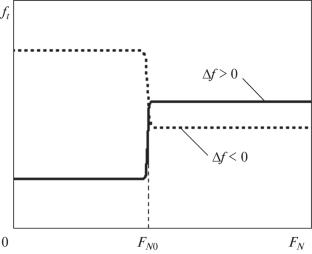固体外滑动摩擦的广义数学模型
IF 0.5
Q4 MATERIALS SCIENCE, MULTIDISCIPLINARY
引用次数: 1
摘要
提出了外滑动摩擦广义三分量数学模型的两种变体。这种方法涉及到Deryagin分子摩擦理论,并允许描述摩擦接触区域中由复杂的物理化学和机械过程引起的摩擦模式的一个或多个变化下摩擦力对负载的依赖。摩擦力的变化具有分段线性特征,而摩擦相互作用的参数如摩擦微分系数、分子吸引力的平衡力和摩擦力的分子分量以s型方式变化。本文章由计算机程序翻译,如有差异,请以英文原文为准。

A Generalized Mathematical Model of External Sliding Friction in Solids
Two variants of the generalized three-component mathematical model of external sliding friction are proposed. This approach involves the Deryagin molecular friction theory and allows describing the dependence of friction force on load under one or more changes in friction modes caused by complex physicochemical and mechanical processes in the friction contact area. The change in friction is shown to have a piecewise linear character, whereas such parameters of frictional interaction as the differential coefficient of friction, the equilibrium force of molecular attraction, and the molecular component of friction force change in a sigmoid manner.
求助全文
通过发布文献求助,成功后即可免费获取论文全文。
去求助
来源期刊

Inorganic Materials: Applied Research
Engineering-Engineering (all)
CiteScore
0.90
自引率
0.00%
发文量
199
期刊介绍:
Inorganic Materials: Applied Research contains translations of research articles devoted to applied aspects of inorganic materials. Best articles are selected from four Russian periodicals: Materialovedenie, Perspektivnye Materialy, Fizika i Khimiya Obrabotki Materialov, and Voprosy Materialovedeniya and translated into English. The journal reports recent achievements in materials science: physical and chemical bases of materials science; effects of synergism in composite materials; computer simulations; creation of new materials (including carbon-based materials and ceramics, semiconductors, superconductors, composite materials, polymers, materials for nuclear engineering, materials for aircraft and space engineering, materials for quantum electronics, materials for electronics and optoelectronics, materials for nuclear and thermonuclear power engineering, radiation-hardened materials, materials for use in medicine, etc.); analytical techniques; structure–property relationships; nanostructures and nanotechnologies; advanced technologies; use of hydrogen in structural materials; and economic and environmental issues. The journal also considers engineering issues of materials processing with plasma, high-gradient crystallization, laser technology, and ultrasonic technology. Currently the journal does not accept direct submissions, but submissions to one of the source journals is possible.
 求助内容:
求助内容: 应助结果提醒方式:
应助结果提醒方式:


